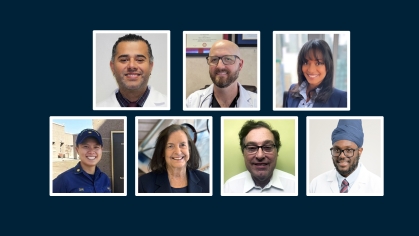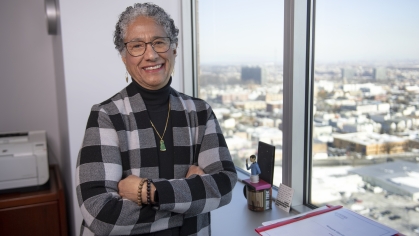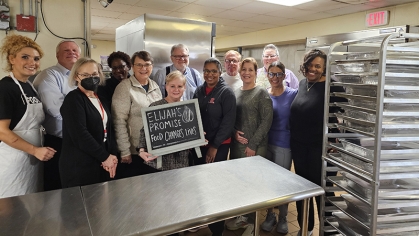How Rutgers Health Mobilized to Fight COVID-19
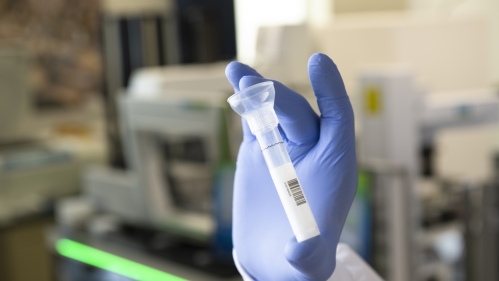
Multiple schools made significant discoveries and provided much-needed care to New Jersey’s disparate communities
Two weeks separated the declaration of the COVID-19 national emergency and the first major countermeasure from Rutgers Health, although this biomedical education, research and health care institution had begun preparing the university for what was coming many weeks before.
Rutgers New Jersey Medical School (NJMS) announced that it would expedite graduation for its 192 final-year students so they could begin treating patients sooner. Rutgers Robert Wood Johnson Medical School (RWJMS), the Rutgers School of Nursing and the Rutgers School of Health Professions announced similar plans shortly thereafter.
Those decisions — which sped many hundreds of caregivers to hospitals and clinics just as surging caseloads threatened to overwhelm the system — illustrated how scale helped Rutgers Health significantly impact the fight against COVID-19.
More illustrations quickly followed.
“We mobilized in an enormous way,” said Chancellor Brian Strom. “It meant putting many other things aside, but we were saving lives locally, statewide, nationally and globally through our research and contributing to real-time solutions.”
One of the keys to effective response was constant communication. Rutgers Health leaders conducted a nightly conference call in the early days of the pandemic to discuss new information about the virus and update each other on the availability of personal protective equipment (PPE), hospital beds, ventilators and other vital resources.
Rutgers also communicated with the public via the New Jersey Poison Control Center’s COVID-19 hotline. “As a statewide, 24/7 hotline staffed by health care professionals, we realized we could help in a unique and valuable way,” said Executive Director Diane Calello.
The center trained hundreds of volunteers, including students from Rutgers’ schools of medicine, pharmacy, nursing, physician assistants and public health. In the early months of the pandemic, the call center received nearly 1,000 calls in a single day. Even after many months had passed, call volume averaged about 500 daily.
Among the first crises of the pandemic was a lack of PPE caused by the deterioration of the nation’s emergency supplies. Rutgers solved this problem by finding Croatian designs for simpler (but still effective) PPE and asking the school of engineering if there was any way the school could manufacture such products on its own. The engineering team quickly devised a way to produce products with 3D printers, and thousands of those products supplied Rutgers-affiliated hospitals until normal PPE supplies became available.
“This is a case where the sheer scope of Rutgers — the breadth of expertise and the ability to coordinate that expertise — sustained and saved lives,” said Senior Vice Chancellor for Clinical Affairs Vicente Gracias.
Another early response to the pandemic that generated major returns — and may continue developing them for years to come — was the creation of a prospective study of COVID-19 exposure in nearly 800 workers at University Hospital in Newark and Robert Wood Johnson University Hospital in New Brunswick.
Dubbed the Rutgers Corona Cohort, the effort includes a series of clinical trials that will explore new drug treatments, antibody testing and long-term health tracking in the hope of providing insight into how to treat the disease and prevent its spread. Data from the cohort already had provided evidence about the efficacy of PPE and other virus-fighting tools and to assess how infection affected patient microbiomes.
In early April, beds began to run short at University Hospital in Newark, so the Rutgers School of Dental Medicine converted its pediatric and special care clinics into a temporary treatment area. The main challenge was creating negative airflow — ensuring air always moved from other parts of the school into the temporary hospital space. The school’s facilities team solved the engineering problem and transformed the space in less than two weeks, providing valuable extra beds to sick patients.
On April 13, one month after the COVID-19 emergency began, the Food and Drug Administration (FDA) granted emergency use authorization to Rutgers for the first saliva-based COVID test. The test was created by RUCDR Infinite Biologics, part of the Human Genetics Institute at Rutgers University–New Brunswick. Jay Tischfield, the Duncan and Nancy MacMillan Distinguished Professor in the Department of Genetics in the Rutgers School of Arts and Sciences, and the late Andrew Brooks, scientific director of RUCDR for 20 years, co-developed the test with contributions from over 100 employees at RUCDR. The pioneering test played a significant role in the fight against the COVID-19 pandemic and earned recognition in The New York Times, CNN and other national media outlets.
The Ernest Mario School of Pharmacy helped facilitate access to COVID-19 testing for the many Rutgers faculty, staff and students who still needed to report to work or clinical rotations in those early days of the pandemic, when nearly everyone else was isolating at home.
“Rutgers researchers couldn’t fight the pandemic via Zoom, so we had to make it safe for them to use their labs,” said Les Barta, director of the pharmacy school’s simulation technology program. “We started with one tool, a very limited supply of PPE and used that to keep safe while we did the tests that led to the approval of our second tool, the saliva tests, which then allowed us to greatly reduce exposure risk.”
The saliva test actually created a double layer of protection. In addition to providing accurate information about infection, it protected health care providers in a way that nasal swabs never did: Isolated patients could drop samples off for analysis without ever coming face-to-face with caregivers, risking further disease spread and making caregivers use fresh PPE at a time when they were running dangerously low.
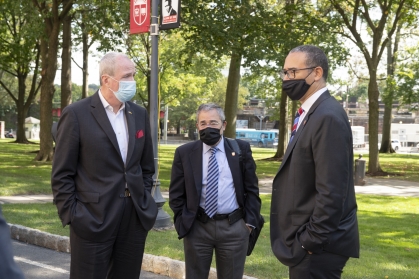
In those earliest days of the pandemic, unexpected challenges arose constantly, inspiring people throughout Rutgers Health and the whole university to improvise responses.
“Rutgers came together to do some amazing things right after hurricanes Irene and Sandy, but I’ve never seen anything like the pandemic response,” Barta said. “When I needed an additional outlet in a room to power an emergency generator, I had an electrician in the room, installing an outlet in less than 12 hours. It’s hard to say what school did what because people from different schools with complementary talents found each other and did what needed to be done with incredible speed. It was, in many ways, an amazing time.”
Test shortages plagued the early months of the pandemic, so only the neediest patients received them. When tests became abundant, however, frequent, widespread testing became a major strategy for COVID-19 containment.
On Rutgers campuses, hundreds of students, staff and faculty volunteered to assemble COVID-19 testing kits. The Office of Clinical and Health Affairs and Rutgers Environmental Health and Safety set up a COVID-19 Testing Kit Factory. Fifty to 100 student volunteers worked at any one time, assembling up to 5,000 kits a week. The team assembled more than 100,000 COVID-19 testing kits for university groups that needed them.
Most of those kits went directly to groups that needed them, but the kit factory team also set up COVID-19 testing kit vending machines on all Rutgers campuses. Volunteers filled the vending machines each week, and users swiped their ID cards to receive a daily kit.
As testing kits became even more available, the New Jersey Department of Health asked Rutgers to identify and train a new workforce of contact tracers.
Officials from the Rutgers School of Public Health hired the state’s first 1,000 COVID contact tracers and created the training courses that ultimately prepared slightly more than 4,000 people for two years of contact tracing. Slightly less than half of those people were state, county or local health officials. The rest were newly hired to help stem the spread of COVID.
“The state obviously wanted everything as fast as possible, so we worked almost non-stop to create the training materials and hire that first thousand new workers,” said Colleen McKay Wharton, program manager at the school’s Center for Public Health Workforce Development.
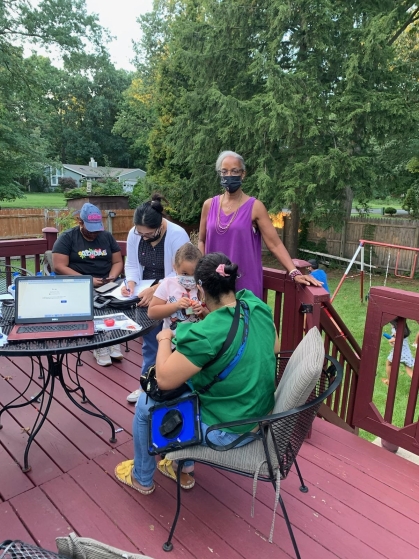
Many of the people who took the course had previous experience with contact tracing because they already worked as disease investigators in local health departments, but many were entirely new to it, so the training course we developed had to teach them the basics of contact tracing and the specifics of the contact-tracing software,” Wharton added.
Another Rutgers-led effort to increase utilization of COVID-19 tests focused on underserved communities.
Rutgers Health helped conduct the NJ HEROES TOO program — short for New Jersey Healthcare Essential Worker Outreach and Education Study - Testing Overlooked Occupations — in collaboration with 18 community-based organizations, four healthcare organizations and $5 million from the National Institutes of Health’s Rapid Acceleration of Diagnostics Underserved Populations Initiative. The study focused on the Black and Hispanic communities disproportionately affected by COVID-19 in places where Rutgers academic medical centers are deeply rooted.
The program had three primary goals:
- Better understand COVID-19 testing patterns among underserved and vulnerable populations,
- Strengthen the data on disparities in infection rates, disease progression and outcomes,
- Develop strategies to reduce the disparities in COVID-19 testing.
Moving from testing to vaccination, faculty from the university’s two medical schools helped run the clinical trials that secured approvals for the vaccines from Moderna, Pfizer and Johnson & Johnson.
NJMS was one of more than 90 American sites throughout the United States to recruit adult volunteers for Moderna’s 30,000-participant mRNA vaccine trial. Preliminary trial results led to the vaccine’s conditional approval months after the study began. Shobha Swaminathan, a professor of medicine at NJMS and her team at Research With a Heart followed participants for more than two years, gathering data about long-term safety and efficacy, resulting in full federal approval for the Moderna vaccine.
Meanwhile, RWJMS was one of the sites chosen to test the Pfizer/BioNTech vaccine in children less than 12 years old. Investigators recruited 209 children for the trial that secured the vaccine’s approval for pediatric use. The school’s contribution to the Johnson & Johnson trial was even larger. It recruited 840 adult volunteers and followed them not only through the initial stage of vaccination but also through the administration of booster shots.
There was a lot of preparation before the trials commenced, such as securing contracts, hiring and training additional staff and getting the word out in the community.
For the Johnson & Johnson trial, the university got permission to email the Rutgers community and alumni who live nearby, notifying them that Rutgers was part of a vaccine trial. After giving their consent online, potential participants were asked by the trial team to complete a confidential survey containing their medical and personal information.
“Using all these avenues, including the study of health care worker participants,” said the principal Rutgers investigator in the J&J trial, Jeffrey Carson — a Distinguished Professor of Medicine at Robert Wood Johnson Medical School and a provost at Rutgers Biomedical and Health Sciences, “We were able to identify about 6,000 people who were eligible for the vaccine trial. Success in clinical research doesn’t happen by chance. Because we were trying to recruit so many people, most of our staff in the clinical research units became dedicated to this study. That made the difference.”
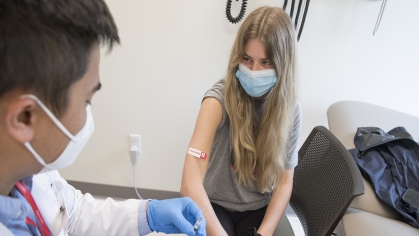
In May 2021, Rutgers opened vaccine clinics in Camden, Piscataway and Newark that could collectively serve 1,350 people a day. After vaccinating enough Rutgers faculty, students and staff to enable campuses to reopen, the university invited anyone who lived, worked or studied in New Jersey to visit its clinics for initial vaccinations or booster shots.
More than 20,000 of those vaccines were administered by the Rutgers Vaccination Corps or, more commonly, the VAX Corps, an interprofessional vaccination team of student volunteers and faculty preceptors led primarily by the schools of pharmacy, nursing, and health professions, who provided student volunteers and faculty preceptors. (As the pandemic winded down, the VAX Corps evolved into the Rutgers Health Service Corps, which aims to provide students from all Rutgers Health schools with service-learning opportunities in public and population health.)
“This work is a prime example of incremental innovation,” said John Hemphill, an associate program manager at the Office of Clinical and Health Affairs. “This all began with an idea to have our students use 3D printing to make face shields for health care workers. After that, we wondered what else could students do to continue combatting COVID, which led to our COVID-19 test kit factory and VAX Corps.”
That initial round of vaccinations marked a turning point in the war against COVID-19, but Rutgers’ efforts to fight the virus continued.
Rutgers Health gave regular webinars to the community, with audiences up to 1,000, to educate members of the public about the state of the pandemic and provide state-of-the-art recommendations about how people could protect themselves and their communities from the ever-evolving virus while living their lives to the fullest.
In late 2021, the Omicron variant led to a surge in hospitalizations. Respirators began running short. Rutgers reached out to Tesla, which had made ventilators and was offering them where needed. In all, Rutgers received approval for up to got 50 ventilators, but there was a major problem. They used different connections than existing ventilators at Rutgers, and there were no adaptors available to connect them with hospital systems.
Once more, coordination between Rutgers Health and the school of engineering saved the day. Rutgers Health officials showed engineers their new ventilators and the connections that were needed, and the engineers devised a way to print adaptors that allowed the ventilators to serve many patients during the Omicron surge.
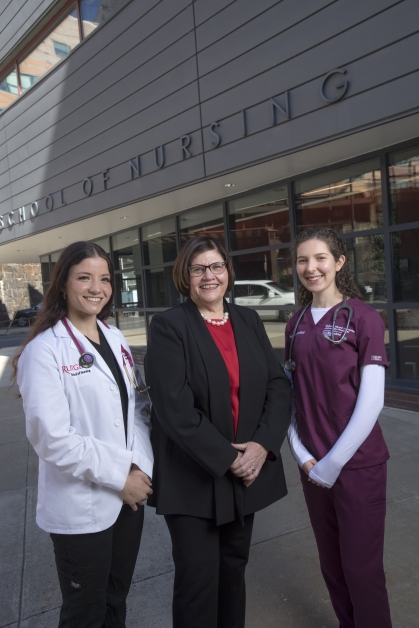
At roughly the same time, New Jersey Health Commissioner Judith Persichilli asked Rutgers and other New Jersey colleges and universities with health sciences programs if they could help tackle the crisis.
Susan Salmond, executive vice dean at Rutgers School of Nursing, responded to the call with a novel idea: Recruit the Student Nurse Reserve Corps.
Salmond contacted colleagues at RWJBarnabas Health, University Hospital and others to see if they could use Rutgers volunteer undergraduate nursing students — some with no clinical experience — to perform tasks that require little training, which would then free up professional nursing staff to focus on more complicated patient care.
The program alleviated staffing shortages during the surge and, of course, can be reactivated if the need arises.
Even without dramatic surges, COVID-19 remains the nation’s third leading cause of death, so Rutgers researchers keep producing innovative ideas for fighting it better. In the past month, Rutgers researchers revealed a machine-learning tool to help hospitals identify life-threatening COVID-19 cases, a breakthrough that could greatly improve outcomes.
The emergency is over, but the war goes on, and Rutgers Health continues to fight it.
RBHS 10th Anniversary
In 10 years, Rutgers Biomedical and Health Sciences (RBHS) has seen transformational achievements that have catalyzed us, changed Rutgers, and benefitted New Jersey and our valued partners and communities.

